Energy Loss Savings Using Direct Current Distribution in a Residential Building with Solar Photovoltaic and Battery Storage
Abstract
1. Introduction
- Experimentally obtained efficiency characteristics of power electronic converters (PECs) and battery cells;
- Quantification of the loss discrepancy when using fixed and load-dependent converter and battery efficiencies;
- Quantification of the effect on the system technical performance of the inclusion of a PV and battery system;
- The magnitude of the loss origins in the AC and DC topologies;
- Statistical identification of most significant correlating factor for DC savings.
2. Theory
2.1. AC Building Topology with PV and Battery System
2.2. Electrical Losses in Buildings
2.2.1. Cable Conduction Losses
2.2.2. Voltage Conversion Losses
3. Case Setup
3.1. Electrical Load and Photovoltaic Profiles
3.2. Proposed DC System Topology with PV and Battery System
3.3. Investigated System Topologies
- AC—230 VAC with load-dependent efficiency.Conventional system. See Figure 1 for the system layout including PV and battery system. Here, cable conduction losses occurred with the 230 VAC distribution.
- DC—380 VDC with load-dependent efficiency.
- DC—380 VDC with fixed converter efficiency.
- DC—380 and 20 VDC with load-dependent efficiency.A 20 VDC sub-voltage level was added to DC and DC to supply the smaller loads and lighting through a central DC/DC converter (see Figure 1 in [37] for an example of such a system topology). Since this "Class A" voltage level is considered not to be dangerous for humans, safety designs are substantially cheaper [38]. Additionally, this sub-voltage level aligns with the supply voltage of the USB Type–C standard.
4. Power Electronic Converter Measurements
4.1. Experimental Setup
4.2. Results—Converter Measurements
5. System Modelling
5.1. Loss Modelling
5.1.1. Cable Conduction Losses
5.1.2. Converter Losses
5.2. Building Performance Metrics
6. Results and Discussion
- The bidirectional converter losses significantly differed when modelled with fixed and load-dependent efficiency characteristics; see cases DC and DC. Assuming constant efficiency as in many previous studies, e.g., [39,44,45], was thus not eligible. As this study was for a residential building with varying net grid interaction, the converter covered the entire load range during operation. Considering the efficiency characteristics of the converter (see Figure 5), the constant efficiency approach was relatively accurate under loading >20% but underestimated the losses below that loading. The results also suggest that with assumed constant efficiency, the DC topology could achieve energy savings even without the inclusion of PV or battery storage, contradicting the findings in [8,9,17]. In relative numbers, the losses of the grid-tied converter using a constant efficiency approach (DC) were 34% lower (or in absolute terms, an underestimation of 63 kWh) than those in the case implementing load-dependent efficiency (DC). Using (14), the system efficiency values of the respective systems (AC and DC) were 95.3, 94.3, 95.8, and 93.7%, respectively.
- Adding a DC sub-voltage level (DC) added 7.3% (29.0 kWh/a) to the total losses when operated at 20 VDC. These added losses also transferred to the load-side conversion (DC/DC) losses, which were 3% higher with DC than in the other cases. The cable conduction losses, identified in [23] as an essential factor to consider, amounted to 2.4 and 1.5% of the total losses in the AC and DC cases, respectively, which is in line with findings in previous works [46,47].
7. Conclusions
Author Contributions
Funding
Data Availability Statement
Acknowledgments
Conflicts of Interest
Nomenclature
| A | Cable cross-section area |
| AC | Alternating current |
| DC | Direct current |
| Annual load demand | |
| Annual losses for topology j | |
| Energy imported from the grid | |
| j | Topology denotation (AC ∨ DC) |
| Rational polynomial curve-fitted constant () | |
| L | Cable length |
| Rational polynomial curve-fitted constant () | |
| NPC | Neutral-point-clamped |
| Power demand from load | |
| Power losses of component “x” | |
| Power to/from source “x” | |
| Gross energy yield from PV modules | |
| Maximum battery (converter) power | |
| PEC | Power Electronic Converter |
| pp | Percentage points |
| PV | Photovoltaic |
| PV energy exported to the grid | |
| Rated battery capacity (Ah) | |
| R | Resistance (in the cable) |
| Internal battery cell resistance | |
| SOC | Battery state of charge |
| SOC | Minimum battery state of charge |
| SOC | Maximum battery state of charge |
| Distribution voltage level | |
| Battery open-circuit voltage | |
| Combined battery efficiency, including converter and battery cell losses | |
| Efficiency of bidirectional grid-tied converter | |
| Efficiency of component “x” | |
| PV utilisation (subscript “PV”) or system efficiency (subscript “system”) | |
| Resistivity in cable material |
Appendix A
| PEC Efficiency | Data Profile | Battery Loss | DC Source | Data Period | Savings * | |||||||
|---|---|---|---|---|---|---|---|---|---|---|---|---|
| Ref. | Building Type | Load-Dependent | Fixed | Synthetic | Measured | Load-Dependent | Fixed | PV | Battery | Single Day(s) | Full Year | % |
| [8] | Residential | (✓) a | ✓ | ✓ | ✓ | ✓ | ✓ | 9–20 b | ||||
| [9] | Residential | ✓c | ✓ | ✓ | ✓ | ✓ | ✓ | 5 d | ||||
| [11] | Residential | ✓ | ✓ | – | – | ✓ | ✓e | 4–10% f | ||||
| [12] | Residential | ✓ | ✓ | – | – | ✓e | −6–−2% | |||||
| [15] | Residential | (✓) g | ✓ | ✓g | ✓ | ✓ | ✓ | – h | ||||
| [17] | Commercial | (✓) g | ✓ | ✓ | ✓ | ✓ | ✓ | 1–18% i | ||||
| [18] | Residential | ✓ | ✓ | – | – | ✓ | ✓ | – h | ||||
| [19] | Commercial | ✓ | ✓ | ✓ | ✓ | ✓ | ✓ | 5% | ||||
| [20] | Commercial | (✓) j | ✓ | ✓ | ✓ | ✓ | ✓ | 2–5% | ||||
| [21] | Residential | (✓) k | ✓ | – | – | ✓ | ✓ | – h | ||||
| [27] | Residential | ✓ | ✓ | ✓ | ✓ | ✓ | ✓ | 1–9% l | ||||
| This work | Residential | ✓ | ✓ | ✓ | ✓ | ✓ | ✓ | Section 6 | ||||
| DC/DC | DC/DC | PV | AC/DC | DC/AC | |
|---|---|---|---|---|---|
| 0.9887 | 0.9876 | 0.9843 | 0.9617 | 0.9621 | |
| 0.607 | 0.662 | ||||
| 0.0021 | 0.0028 | 0.0015 | 0.615 | 0.667 | |
| 0.003 | 0.002 | ||||
| R | 1.000 | 1.000 | 0.999 | 0.999 | 1.000 |
| RMSE | 0.0019 | 0.0014 | 0.0024 | 0.0019 | 0.0008 |
References
- Bloomberg. New Energy Outlook 2019; Bloomberg New Energy Finance (BNEF): Lodon, UK, 2019. [Google Scholar]
- IEA. 2018 Snapshot of Global Photovoltaic Markets; IEA PVPS TCP: Paris, France, 2018; ISBN 978-3-906042-72-5. [Google Scholar]
- Elsayed, A.T.; Mohamed, A.A.; Mohammed, O.A. DC microgrids and distribution systems: An overview. Electr. Power Syst. Res. 2015, 119, 407–417. [Google Scholar] [CrossRef]
- Patterson, B.T. DC, come home: DC microgrids and the birth of the “enernet”. IEEE Power Energy Mag. 2012, 10, 60–69. [Google Scholar] [CrossRef]
- Chub, A.; Vinnikov, D.; Korkh, O.; Malinowski, M.; Kouro, S. Ultra-Wide Voltage Gain Range Microconverter for Integration of Silicon and Thin-Film Photovoltaic Modules in DC Microgrids. IEEE Trans. Power Electron. 2021, 36, 13763–13778. [Google Scholar] [CrossRef]
- Rodriguez-Diaz, E.; Savaghebi, M.; Vasquez, J.C.; Guerrero, J.M. An overview of low voltage DC distribution systems for residential applications. In Proceedings of the 2015 IEEE 5th International Conference on Consumer Electronics-Berlin (ICCE-Berlin), Berlin, Germany, 6–9 September 2015; pp. 318–322. [Google Scholar] [CrossRef]
- Vossos, V.; Johnson, K.; Kloss, M.; Khattar, M.; Gerber, D.; Brown, R. Review of DC Power Distribution in Buildings: A Technology and Market Assessment; LBNL Report; University of California at Berkeley: Berkeley, CA, USA, 2017. [Google Scholar] [CrossRef]
- Glasgo, B.; Azevedo, I.L.; Hendrickson, C. How much electricity can we save by using direct current circuits in homes? Understanding the potential for electricity savings and assessing feasibility of a transition towards DC powered buildings. Appl. Energy 2016, 180, 66–75. [Google Scholar] [CrossRef]
- Vossos, V.; Garbesi, K.; Shen, H. Energy savings from direct-DC in US residential buildings. Energy Build. 2014, 68, 223–231. [Google Scholar] [CrossRef]
- Ollas, P. Energy Savings Using a Direct-Current Distribution Network in a PV & Battery Equipped Residential Building. Ph.D. Thesis, Department of Electrical Engineering, Chalmers University of Technology, Göteborg, Sweden, 2020. [Google Scholar]
- Siraj, K.; Khan, H.A. DCdistribution for residential power networks—A framework to analyze the impact of voltage levels on energy efficiency. Energy Rep. 2020, 6, 944–951. [Google Scholar] [CrossRef]
- Dastgeer, F.; Gelani, H.E. A Comparative analysis of system efficiency for AC and DC residential power distribution paradigms. Energy Build. 2017, 138, 648–654. [Google Scholar] [CrossRef]
- Savage, P.; Nordhaus, R.; Jamieson, S. DC Microgrids: Benefits and Barriers, from Silos to Systems: Issues in Clean Energy and Climate Change; Yale School of Forestry and Environmental Studies: New Haven, CT, USA, 2010. [Google Scholar]
- Starke, M.; Tolbert, L.M.; Ozpineci, B. AC vs. DC distribution: A loss comparison. In Proceedings of the 2008 IEEE/PES Transmission and Distribution Conference and Exposition, Chicago, IL, USA, 21–24 April 2008; pp. 1–7. [Google Scholar] [CrossRef]
- Gelani, H.E.; Dastgeer, F.; Siraj, K.; Nasir, M.; Niazi, K.A.K.; Yang, Y. Efficiency comparison of AC and DC distribution networks for modern residential localities. Appl. Sci. 2019, 9, 582. [Google Scholar] [CrossRef]
- Dastgeer, F.; Gelani, H.E.; Anees, H.M.; Paracha, Z.J.; Kalam, A. Analyses of efficiency/energy-savings of DC power distribution systems/microgrids: Past, present and future. Int. J. Electr. Power Energy Syst. 2019, 104, 89–100. [Google Scholar] [CrossRef]
- Gerber, D.L.; Vossos, V.; Feng, W.; Marnay, C.; Nordman, B.; Brown, R. A simulation-based efficiency comparison of AC and DC power distribution networks in commercial buildings. Appl. Energy 2018, 210, 1167–1187. [Google Scholar] [CrossRef]
- Ahmad, F.; Dastgeer, F.; Gelani, H.E.; Khan, S.; Nasir, M. Comparative analyses of residential building efficiency for AC and DC distribution networks. Bull. Pol. Acad. Sci. Tech. Sci. 2021, 69, e136732. [Google Scholar] [CrossRef]
- Alshammari, M.; Duffy, M. Feasibility Analysis of a DC Distribution System for a 6 kW Photovoltaic Installation in Ireland. Energies 2021, 14, 6265. [Google Scholar] [CrossRef]
- Spiliotis, K.; Gonçalves, J.E.; Saelens, D.; Baert, K.; Driesen, J. Electrical system architectures for building-integrated photovoltaics: A comparative analysis using a modelling framework in Modelica. Appl. Energy 2020, 261, 114247. [Google Scholar] [CrossRef]
- Chinnathambi, N.D.; Nagappan, K.; Samuel, C.R.; Tamilarasu, K. Internet of things-based smart residential building energy management system for a grid-connected solar photovoltaic-powered DC residential building. Int. J. Energy Res. 2022, 46, 1497–1517. [Google Scholar] [CrossRef]
- Glasgo, B.; Azevedo, I.L.; Hendrickson, C. Expert assessments on the future of direct current in buildings. Environ. Res. Lett. 2018, 13, 074004. [Google Scholar] [CrossRef]
- Gelani, H.E.; Dastgeer, F.; Nasir, M.; Khan, S.; Guerrero, J.M. AC vs. DC Distribution Efficiency: Are We on the Right Path? Energies 2021, 14, 4039. [Google Scholar] [CrossRef]
- Weiss, R.; Ott, L.; Boeke, U. Energy efficient low-voltage DC-grids for commercial buildings. In Proceedings of the 2015 IEEE First International Conference on DC Microgrids (ICDCM), Atlanta, GA, USA, 7–10 June 2015; pp. 154–158. [Google Scholar] [CrossRef]
- Seo, G.S.; Baek, J.; Choi, K.; Bae, H.; Cho, B. Modeling and analysis of DC distribution systems. In Proceedings of the 8th International Conference on Power Electronics-ECCE Asia, Jeju, Republic of Korea, 30 May–3 June 2011; pp. 223–227. [Google Scholar] [CrossRef]
- Gelani, H.E.; Dastgeer, F. Efficiency analyses of a DC residential power distribution system for the modern home. Adv. Electr. Comput. Eng. 2015, 15, 135–143. [Google Scholar] [CrossRef]
- Ollas, P.; Thiringer, T.; Chen, H.; Markusson, C. Increased photovoltaic utilisation from direct current distribution: Quantification of geographical location impact. Prog. Photovoltaics Res. Appl. 2021, 29, 846–856. [Google Scholar] [CrossRef]
- Ammous, A.; Assaedi, A.; Al Ahdal, A.; Ammous, K. Energy efficiency of a novel low voltage direct current supply for the future building. Int. J. Energy Res. 2021, 45, 15360–15371. [Google Scholar] [CrossRef]
- Li, J.; Danzer, M.A. Optimal charge control strategies for stationary photovoltaic battery systems. J. Power Sources 2014, 258, 365–373. [Google Scholar] [CrossRef]
- IEC. Conductors of Insulated Cables; Technical Report IEC 60228:2004; International Electrotechnical Commission: Geneva, Switzerland, 2004. [Google Scholar]
- Issi, F.; Kaplan, O. The determination of load profiles and power consumptions of home appliances. Energies 2018, 11, 607. [Google Scholar] [CrossRef]
- Pipattanasomporn, M.; Kuzlu, M.; Rahman, S.; Teklu, Y. Load profiles of selected major household appliances and their demand response opportunities. IEEE Trans. Smart Grid 2013, 5, 742–750. [Google Scholar] [CrossRef]
- Alliance, E. 380 VDC Architectures for the Modern Data Center; EMerge Alliance: San Ramon, CA, USA, 2013. [Google Scholar]
- Geary, D.E.; Mohr, D.P.; Owen, D.; Salato, M.; Sonnenberg, B. 380V DC eco-system development: Present status and future challenges. In Proceedings of the Intelec 2013, 35th International Telecommunications Energy Conference, Smart Power and Efficiency, VDE, Hamburg, Germany, 13–17 October 2013; pp. 1–6. [Google Scholar]
- Becker, D.J.; Sonnenberg, B. DC microgrids in buildings and data centers. In Proceedings of the 2011 IEEE 33rd International Telecommunications Energy Conference (INTELEC), Amsterdam, The Netherlands, 9–13 October 2011; pp. 1–7. [Google Scholar] [CrossRef]
- Manandhar, U.; Ukil, A.; Jonathan, T.K.K. Efficiency comparison of DC and AC microgrid. In Proceedings of the 2015 IEEE Innovative Smart Grid Technologies-Asia (ISGT ASIA), Bangkok, Thailand, 3–6 November 2015; pp. 1–6. [Google Scholar] [CrossRef]
- Gerber, D.L.; Liou, R.; Brown, R. Energy-saving opportunities of direct-DC loads in buildings. Appl. Energy 2019, 248, 274–287. [Google Scholar] [CrossRef]
- ISO. Electrically Propelled Road Vehicles—Safety Specifications—Part 1: Rechargeable Energy Storage System (RESS); Technical Report ISO 6469-1:2019; International Organization for Standardization: Geneva, Switzerland, 2019. [Google Scholar]
- Backhaus, S.N.; Swift, G.W.; Chatzivasileiadis, S.; Tschudi, W.; Glover, S.; Starke, M.; Wang, J.; Yue, M.; Hammerstrom, D. DC Microgrids Scoping Study. Estimate of Technical and Economic Benefits; Technical Report; Los Alamos National Lab. (LANL): Los Alamos, NM, USA, 2015.
- Fregosi, D.; Ravula, S.; Brhlik, D.; Saussele, J.; Frank, S.; Bonnema, E.; Scheib, J.; Wilson, E. A comparative study of DC and AC microgrids in commercial buildings across different climates and operating profiles. In Proceedings of the 2015 IEEE First International Conference on DC Microgrids (ICDCM), Atlanta, GA, USA, 7–10 June 2015; pp. 159–164. [Google Scholar] [CrossRef]
- Noritake, M.; Yuasa, K.; Takeda, T.; Hoshi, H.; Hirose, K. Demonstrative research on DC microgrids for office buildings. In Proceedings of the 2014 IEEE 36th International Telecommunications Energy Conference (INTELEC), Vancouver, BC, Canada, 28 September–2 October 2014; pp. 1–5. [Google Scholar] [CrossRef]
- Planas, E.; Andreu, J.; Gárate, J.I.; De Alegría, I.M.; Ibarra, E. AC and DC technology in microgrids: A review. Renew. Sustain. Energy Rev. 2015, 43, 726–749. [Google Scholar] [CrossRef]
- Ollas, P.; Persson, J.; Markusson, C.; Alfadel, U. Impact of Battery Sizing on Self-Consumption, Self-Sufficiency and Peak Power Demand for a Low Energy Single-Family House With PV Production in Sweden. In Proceedings of the 2018 IEEE 7th World Conference on Photovoltaic Energy Conversion (WCPEC) (A Joint Conference of 45th IEEE PVSC, 28th PVSEC & 34th EU PVSEC), Big Island, HI, USA, 10–15 June 2018; pp. 0618–0623. [Google Scholar] [CrossRef]
- Sannino, A.; Postiglione, G.; Bollen, M.H. Feasibility of a DC network for commercial facilities. In Proceedings of the Conference Record of the 2002 IEEE Industry Applications Conference, 37th IAS Annual Meeting (Cat. No. 02CH37344), Pittsburgh, PA, USA, 13–18 October 2002; Volume 3, pp. 1710–1717. [Google Scholar] [CrossRef]
- Thomas, B.A.; Azevedo, I.L.; Morgan, G. Edison Revisited: Should we use DC circuits for lighting in commercial buildings? Energy Policy 2012, 45, 399–411. [Google Scholar] [CrossRef]
- Boeke, U.; Wendt, M. DC power grids for buildings. In Proceedings of the 2015 IEEE First International Conference on DC Microgrids (ICDCM), Atlanta, GA, USA, 7–10 June 2015; pp. 210–214. [Google Scholar] [CrossRef]
- Brenguier, J.; Vallet, M.; Vaillant, F. Efficiency gap between AC and DC electrical power distribution system. In Proceedings of the 2016 IEEE/IAS 52nd Industrial and Commercial Power Systems Technical Conference (I&CPS), Detroit, MI, USA, 1–5 May 2016; pp. 1–6. [Google Scholar] [CrossRef]
- Ramadhani, U.H.; Shepero, M.; Munkhammar, J.; Widen, J.; Etherden, N. Review of probabilistic load flow approaches for power distribution systems with photovoltaic generation and electric vehicle charging. Int. J. Electr. Power Energy Syst. 2020, 120, 106003. [Google Scholar] [CrossRef]
- Vossos, V.; Gerber, D.; Bennani, Y.; Brown, R.; Marnay, C. Techno-economic analysis of DC power distribution in commercial buildings. Appl. Energy 2018, 230, 663–678. [Google Scholar] [CrossRef]
- Vossos, V.; Gerber, D.L.; Gaillet-Tournier, M.; Nordman, B.; Brown, R.; Bernal Heredia, W.; Ghatpande, O.; Saha, A.; Arnold, G.; Frank, S.M. Adoption Pathways for DC Power Distribution in Buildings. Energies 2022, 15, 786. [Google Scholar] [CrossRef]
- Awad, H.; Gül, M. Load-match-driven design of solar PV systems at high latitudes in the Northern hemisphere and its impact on the grid. Sol. Energy 2018, 173, 377–397. [Google Scholar] [CrossRef]
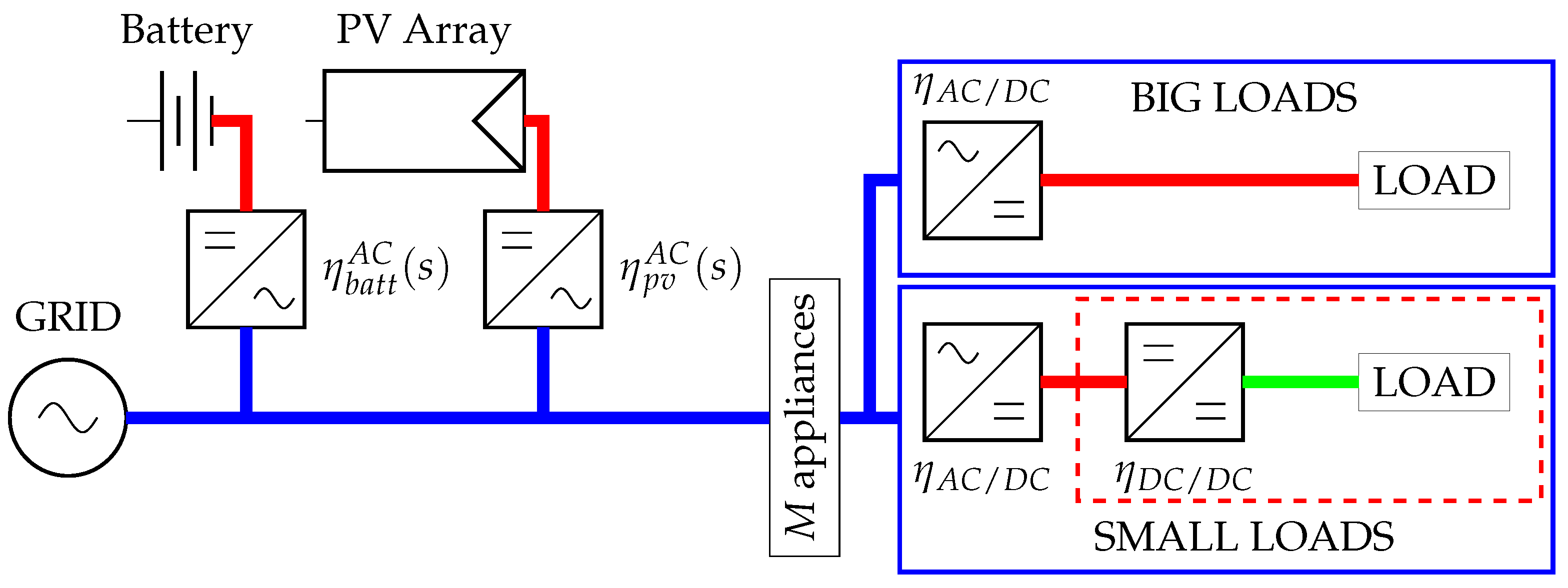

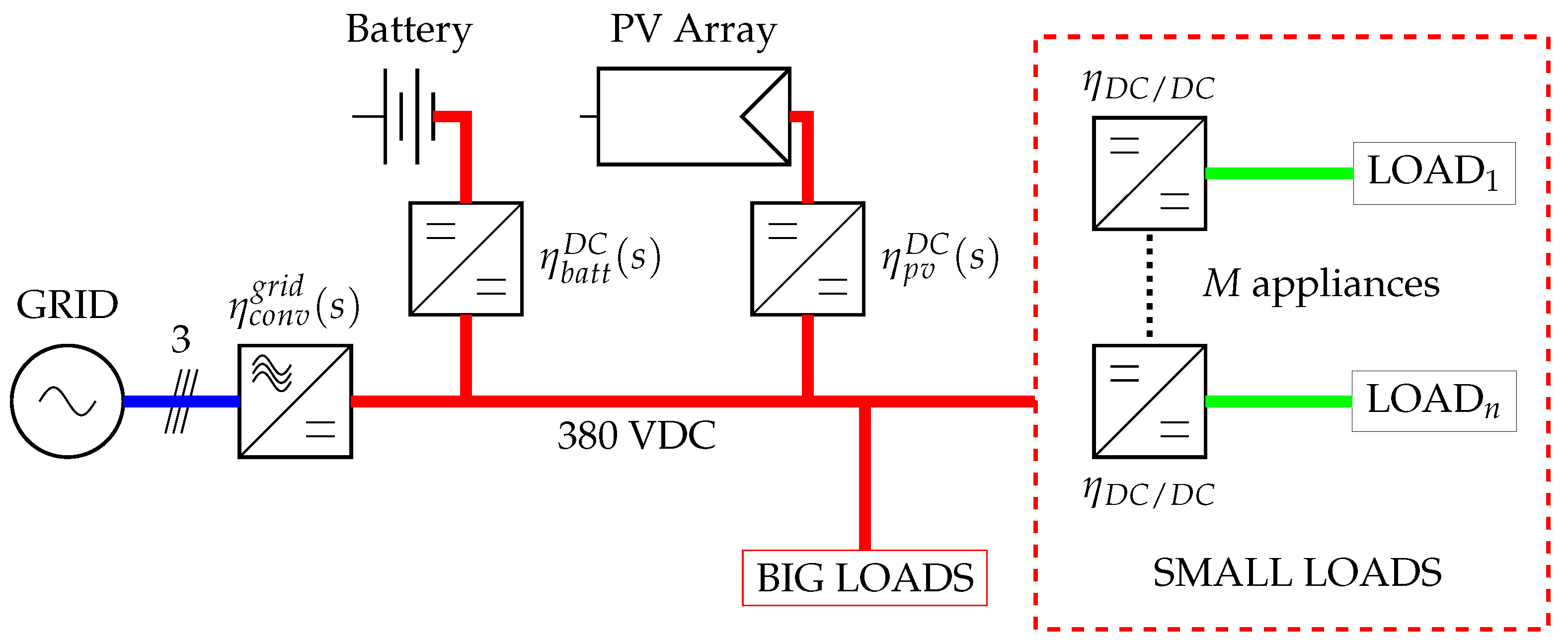

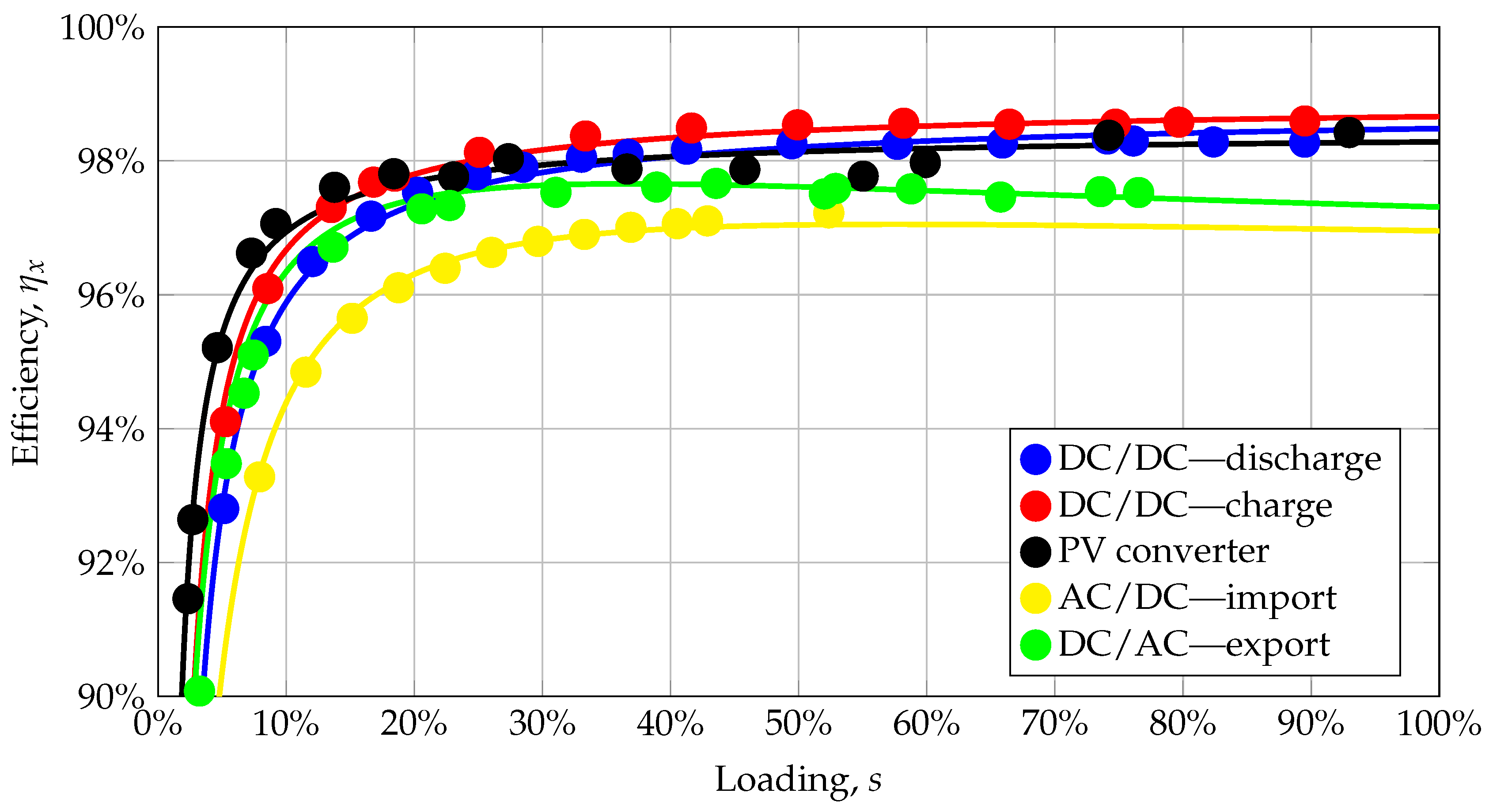

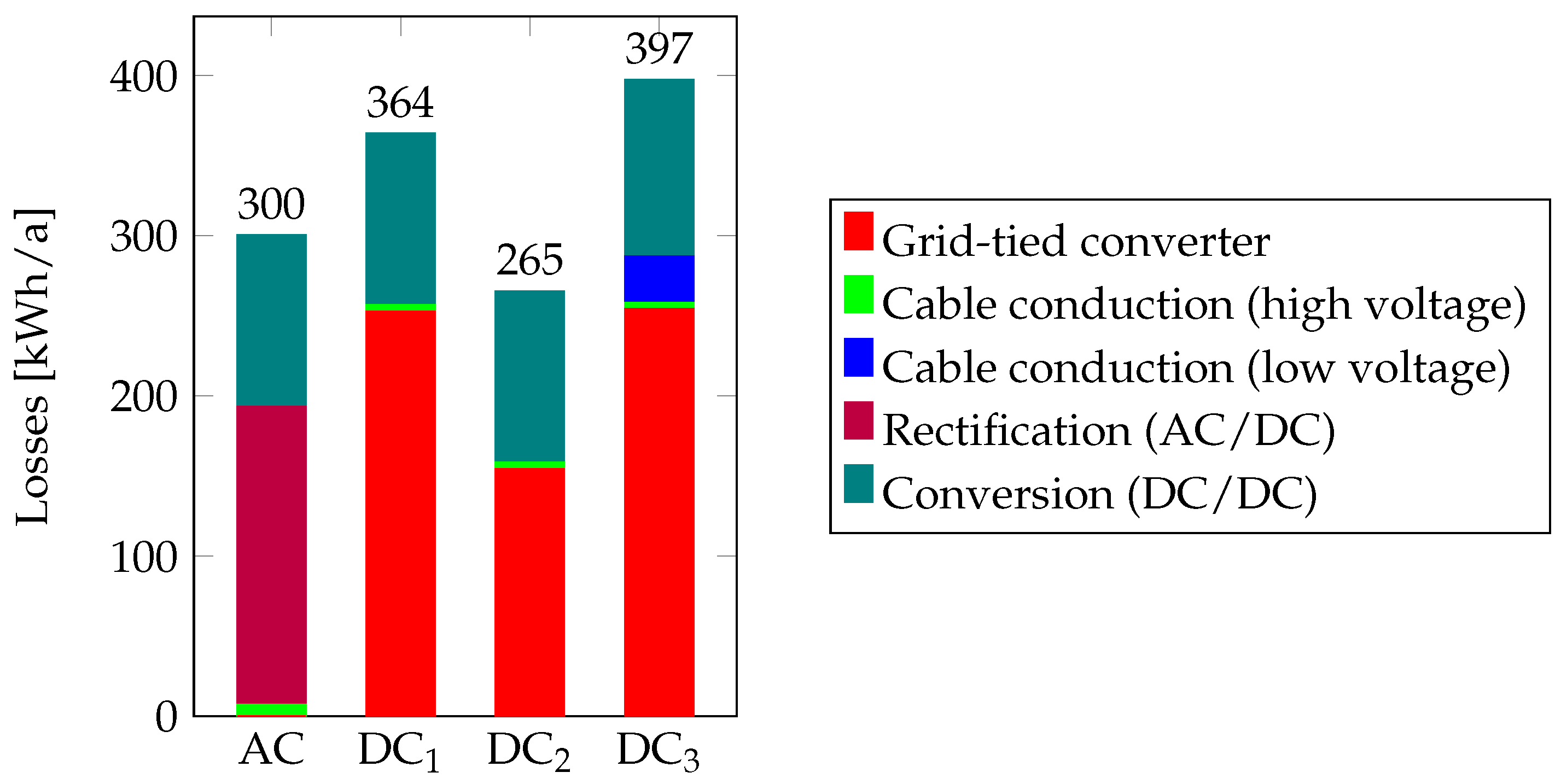
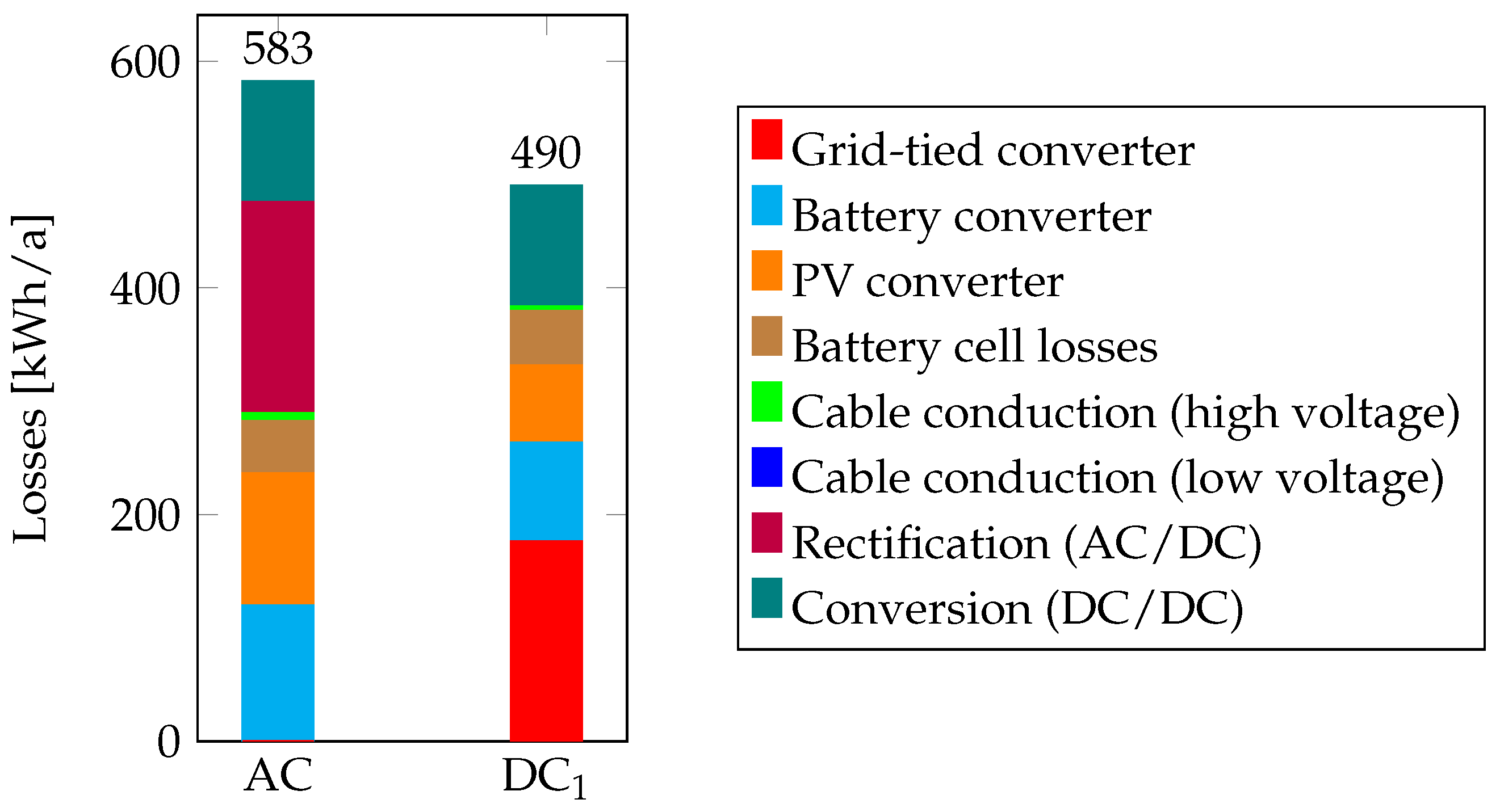
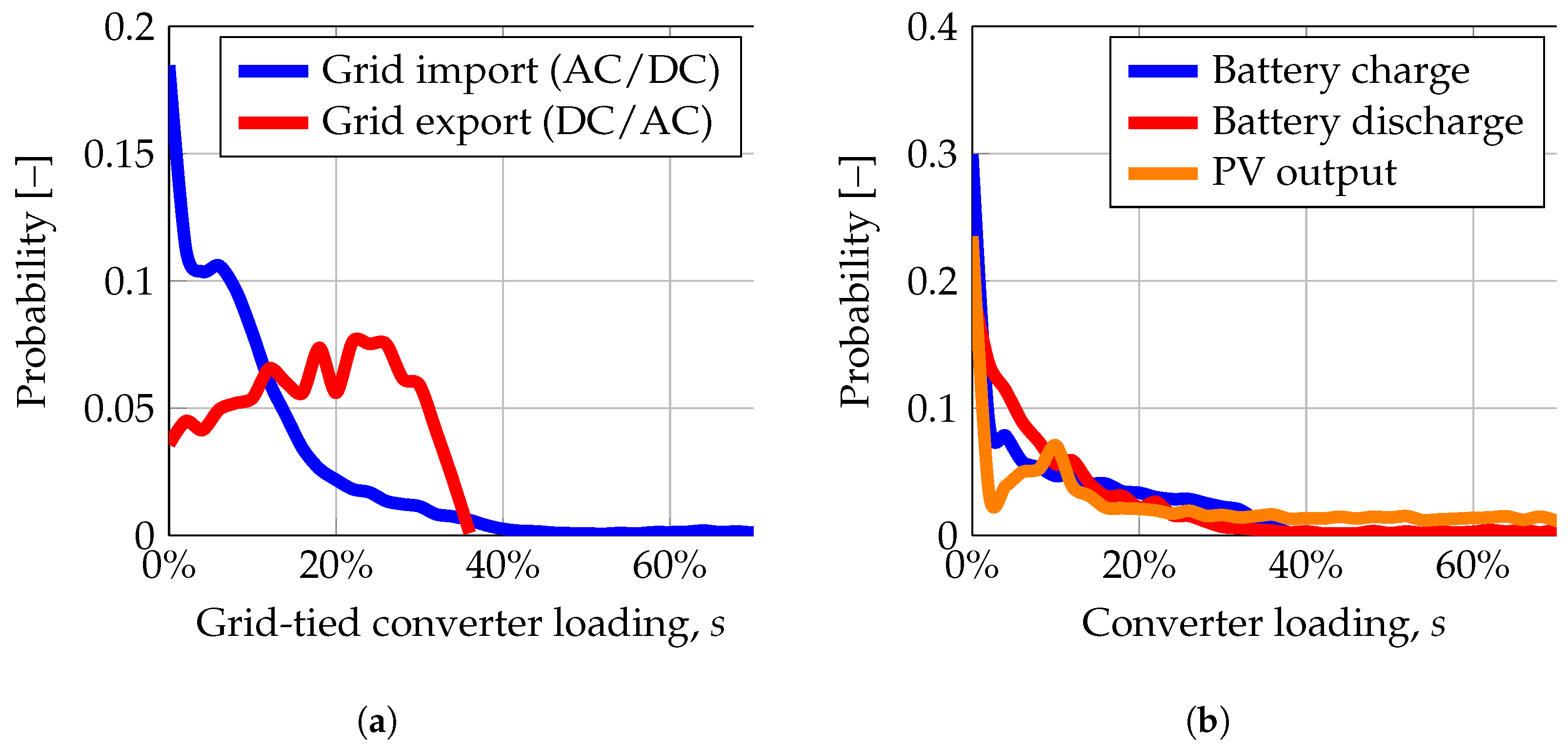

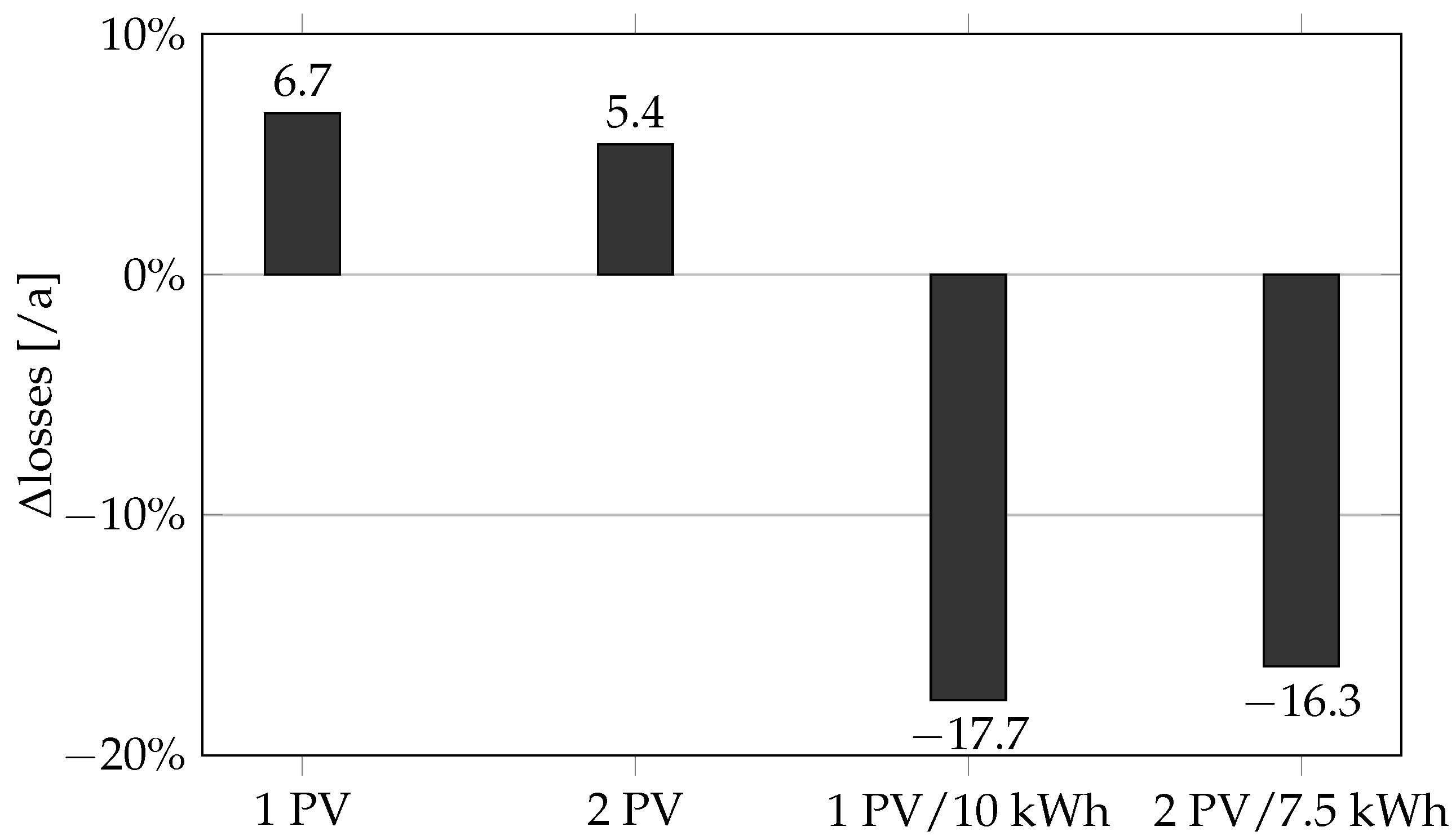

| Current (A) | Cross-Section (mm) | Resistance (/m) |
|---|---|---|
| 6 | 0.75 | 0.023 |
| 10 | 1.5 | 0.011 |
| 16 | 2.5 | 0.007 |
| 20 | 4 | 0.004 |
| Efficiency/Case | AC | DC | DC | DC |
|---|---|---|---|---|
| (%) | 100 | 97.6 1 | ||
| (%) | 98.5 1 | |||
| (%) | 98.3 1 | |||
| (%) [10] | 97 | 100 | 100 | 100 |
| (%) [10] | 87 | 87 | 87 | 87 |
| AC | DC | Difference (%) | |
|---|---|---|---|
| System losses (kWh) | 583 | 490 | −15.8 |
| PV energy (kWh) | 3113 | 3161 | 1.5 |
| (%) | 91.3 | 93.7 | 2.6 |
| (%) | 90.8 | 92.3 | 1.7 |
Disclaimer/Publisher’s Note: The statements, opinions and data contained in all publications are solely those of the individual author(s) and contributor(s) and not of MDPI and/or the editor(s). MDPI and/or the editor(s) disclaim responsibility for any injury to people or property resulting from any ideas, methods, instructions or products referred to in the content. |
© 2023 by the authors. Licensee MDPI, Basel, Switzerland. This article is an open access article distributed under the terms and conditions of the Creative Commons Attribution (CC BY) license (https://creativecommons.org/licenses/by/4.0/).
Share and Cite
Ollas, P.; Thiringer, T.; Persson, M.; Markusson, C. Energy Loss Savings Using Direct Current Distribution in a Residential Building with Solar Photovoltaic and Battery Storage. Energies 2023, 16, 1131. https://doi.org/10.3390/en16031131
Ollas P, Thiringer T, Persson M, Markusson C. Energy Loss Savings Using Direct Current Distribution in a Residential Building with Solar Photovoltaic and Battery Storage. Energies. 2023; 16(3):1131. https://doi.org/10.3390/en16031131
Chicago/Turabian StyleOllas, Patrik, Torbjörn Thiringer, Mattias Persson, and Caroline Markusson. 2023. "Energy Loss Savings Using Direct Current Distribution in a Residential Building with Solar Photovoltaic and Battery Storage" Energies 16, no. 3: 1131. https://doi.org/10.3390/en16031131
APA StyleOllas, P., Thiringer, T., Persson, M., & Markusson, C. (2023). Energy Loss Savings Using Direct Current Distribution in a Residential Building with Solar Photovoltaic and Battery Storage. Energies, 16(3), 1131. https://doi.org/10.3390/en16031131






